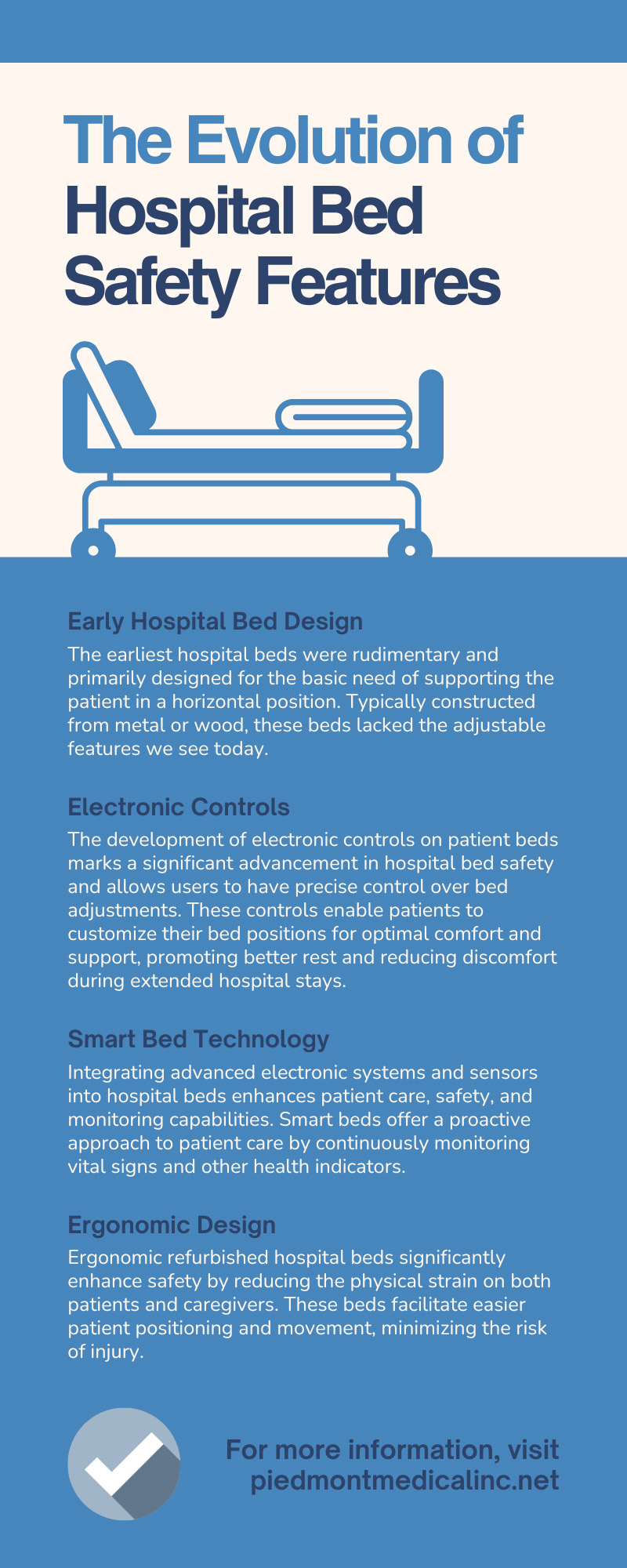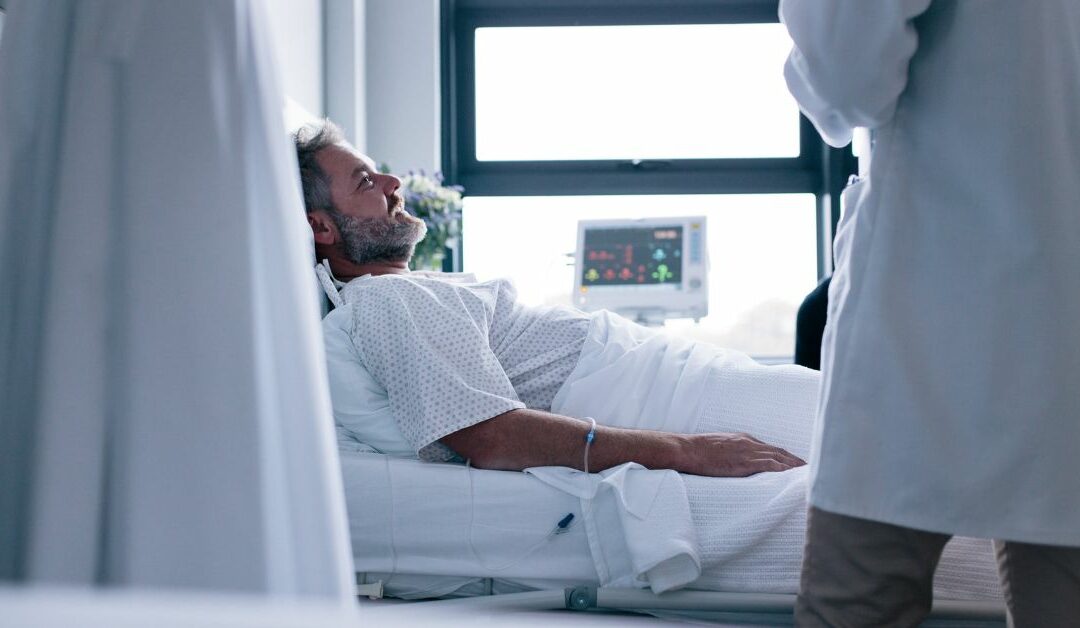Hospital bed safety features protect patient well-being and prevent injuries. These features support patients’ physical health and comfort and allow for efficient care from medical providers. With advancements in medical technology, the evolution of hospital bed safety features has significantly improved patient care.
Early Hospital Bed Design
The earliest hospital beds were rudimentary and primarily designed for the basic need of supporting the patient in a horizontal position. Typically constructed from metal or wood, these beds lacked the adjustable features we see today.
The development of the first safety features began with the introduction of side rails. Initially, these rails were fixed and aimed at preventing patients from accidentally falling out of bed. Over time, as medical care evolved, side rails became adjustable and more sophisticated, setting the foundation for the advanced safety systems found in modern hospital beds.
Electronic Controls
The development of electronic controls on patient beds marks a significant advancement in hospital bed safety and allows users to have precise control over bed adjustments. These controls enable patients to customize their bed positions for optimal comfort and support, promoting better rest and reducing discomfort during extended hospital stays. Additionally, caregivers benefit from the convenience of remotely adjusting bed settings, which enhances patient care efficiency and minimizes manual handling requirements, ultimately improving the overall patient experience.
Integrated Bed Exit Alarms
Patients leaving their beds unsupervised can pose significant risks, including falls that may result in fractures, head injuries, or other serious complications. These incidents can lead to prolonged hospital stays, increased healthcare costs, and a negative impact on patient recovery and safety.
Bed exit alarms integrated with electronic controls provide real-time alerts to medical staff when patients attempt to leave their beds unsafely. These alarms use sensors and pressure pads to detect changes in bed weight, triggering an audible or visual alarm. Integrated alarms allow healthcare providers to respond promptly and provide appropriate assistance, reducing the risk of patient falls.
Pressure-Relieving Components
Pressure-relieving hospital bed features typically include specialized mattresses or overlays that distribute pressure evenly and reduce the risk of skin breakdown. By using materials that conform to the body’s contours, pressure-relieving surfaces alleviate pressure points, promote circulation, and improve overall skin integrity, particularly in immobile or bedridden patients.
Pressure ulcers, also known as bedsores, pose serious health risks. If left untreated, they can lead to skin breakdown, tissue damage, and infections. These ulcers typically develop in areas where prolonged pressure restricts blood flow to the skin and underlying tissues, resulting in pain, open wounds, and potential complications such as sepsis. These risks highlight how pressure-relieving mattresses promote patient safety and wellness.
Smart Bed Technology
Integrating advanced electronic systems and sensors into hospital beds enhances patient care, safety, and monitoring capabilities. Smart beds offer a proactive approach to patient care by continuously monitoring vital signs and other health indicators. This technology not only enhances patient safety but also streamlines healthcare operations by providing actionable insights.
Here are some features and benefits of hospital smart beds:
- Integrated sensors to monitor patient vital signs and movement during sleep.
- Remote access capabilities that allow healthcare providers to track patient data and respond promptly.
- Automated alerts for nurses or caregivers regarding changes in patient position or vital sign anomalies.
- Data analytics tools to analyze sleep patterns and trends for personalized patient care.
Specialized Construction: Bariatric Beds
Bariatric hospital beds have been developed to safely accommodate larger patients and facilitate clinical care delivery. Their higher weight capacities and reinforced structures ensure stability, preventing dangerous tipping.
Bariatric beds come equipped with advanced features that facilitate easier patient handling and positioning. Often, these beds include powered lift mechanisms and adjustable widths that enable caregivers to move and reposition patients with minimal physical strain. Bariatric beds help prevent injuries to staff and improve overall workflow efficiency in healthcare settings by reducing the manual effort required to perform various tasks.
Infection Control
Infection control features on hospital beds are designed to minimize the risk of hospital-associated infections (HAIs) that patients acquire while receiving medical treatment in a healthcare facility, such as a hospital. HAIs pose a significant problem because they can lead to serious health complications, prolonged hospital stays, and increased medical costs. Additionally, HAIs can contribute to the spread of antibiotic-resistant bacteria, making infections harder to treat and control.
Modern hospital beds often have antimicrobial surfaces and materials that inhibit the growth of bacteria and pathogens. Additionally, easy-to-clean designs ensure caregivers can effectively sanitize the beds between uses, reducing cross-contamination risks.
Such infection control measures promote patient safety by maintaining a hygienic environment. The inclusion of antimicrobial coatings and seamless surfaces prevents bacteria buildup, which is crucial in high-traffic hospital settings. These features not only protect patients but also enhance the overall health and safety standards within healthcare facilities.
Ergonomic Design
Ergonomic refurbished hospital beds significantly enhance safety by reducing the physical strain on both patients and caregivers. These beds facilitate easier patient positioning and movement, minimizing the risk of injury. Additionally, ergonomic designs ensure healthcare providers can perform their duties efficiently, further contributing to a safer and more effective care environment.
The following ergonomic design features improve safety and comfort:
- Lumbar support: Provides enhanced back support for patients, reducing discomfort during extended bed rest.
- Intuitive control panels: Simplifies bed adjustments for both patients and caregivers, ensuring ease of use and quick responses to patient needs.
- Flexible head and foot sections: Allows users to customize bed positioning to enhance patient comfort and assist in clinical treatments.
- Slide guards: Prevents the patient from sliding down in bed, reducing the need for frequent repositioning by caregivers.
- Built-in storage compartments: Conveniently holds essential items, reducing the need for caregivers to leave patients unattended.
- Handrails with grip support: Provides patients with a secure grasp to help them safely get in and out of bed, reducing fall risks.
- Foot control pedals: Enables caregivers to adjust the bed without the need to use their hands, maintaining sterility and efficiency during procedures.
Enhanced hospital bed design promotes safety, comfort, and efficiency. These beds provide sophisticated adjustments, integrated monitoring, and infection control measures. Specialized beds, such as bariatric designs, and ergonomic improvements address specific clinical needs, enhancing both patient and caregiver safety. Collectively, these innovations underscore how continuously improving medical equipment facilitates quality healthcare.



Recent Comments